Baring Mind and Soul – Tan Swie Hian
After a long absence of 43 years, Singapore’s celebrated multi-hyphenate artist returns to the National Library with a new solo exhibition. Chung Sang Hong tells you more.
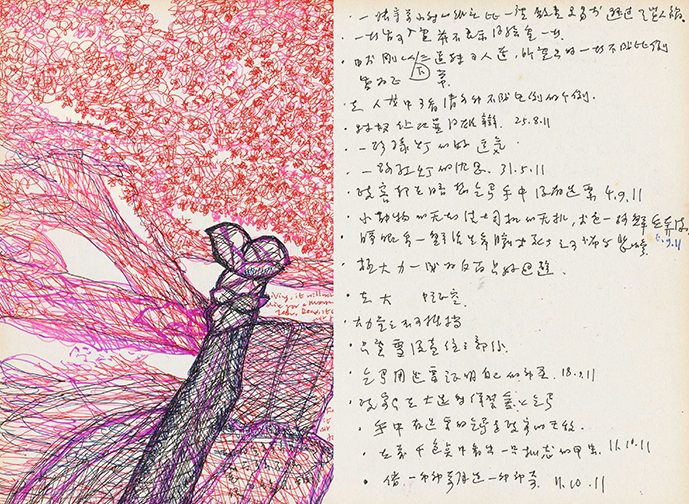
Journaling has been used by great artists since time immemorial. Michelangelo’s notebooks are not only a priceless archive of his creative inspirations but also offer a rare glimpse into his private life. From snippets of poetry, random doodles and ethereal drawings to memos and practical listings of food and expenses, the notebooks cast a light into the Italian master’s inner world; the connections and juxtapositions of words and images divulge the thinking and creative processes behind his works.[^1]
That same deep introspection, an intimate baring of the mind and soul as it were, is similarly revealed in the private notebooks of Tan Swie Hian, whom Time magazine proclaimed in 2003 as “Singapore’s Renaissance man”.[^2] For those who are familiar with the works of Tan, this epithet is a justifiably fitting tribute.
Now for the first time, the National Library, Singapore, presents the acclaimed artist’s never-before-published notebooks as well as his celebrated works of art and writings in an exhibition entitled “Anatomy of a Free Mind: Tan Swie Hian’s Notebooks and Creations”. To be showcased at level 10 of the National Library Building, the exhibition opens its doors to the public on 22 November 2016.
The notebooks, which Tan has since donated to the National Library, are key to understanding the psyche and creative thinking of this much-lauded artist. Containing sketches, drawings and writings, they are a window to Tan’s formidable mind, which he describes as an “immense web with myriads of beings hanging.”[^3] The exhibition aims to draw people into the unfettered mind and soul of the artist, and reveal how his ideas, passions, philosophical insights and spiritual enlightenment are manifested through his artistic and literary creations.
Tan refers to his notebooks as his “secret garden”, and he is thus the diligent and disciplined “gardener” who painstakingly and lovingly cultivates and nurtures the seedlings of inspiration. So intrinsically important are these notebooks that Tan considers them as his “companions in life”: they never leave his side – they are stashed into his briefcase, they clutter his desk and even his bedside.
The pages are filled from cover to cover, with almost every square inch of space used for his creative musings – sketches of visions from his meditations, drawings of his inner and outer realities, poetry verses, revisited memories, reflections on his latest creations, annotations of ancient classical texts he has read, and more.[^4]
To Tan, the notebooks serve the important purpose of documentation and reference – as a cerebral artist he writes before, during or after the execution of his works – and to the interested observer, they offer rare vistas of the artist’s creative mindscape.
Singapore’s Renaissance Man
Tan Swie Hian was born in Indonesia in 1943 and moved to Singapore when he was three. While as a student at the Chinese High School, Tan already displayed his prodigious talents in art, calligraphy and poetry. He later pursued a degree in Modern Languages and Literature at Nanyang University, graduating in 1968. In the same year he published his first anthology, The Giant – a collection of Chinese modernist poetry – a landmark work that earned him recognition as a poet of standing.[^5] Since then, Tan has published close to 40 collections of poetry, essays, novels, fables, critiques and translated works.
The year 1973 was a turning point in Tan’s life: he received spiritual illumination for the first time and deepened his faith in Buddhism. After this metaphysical awakening, Tan channelled his creative energies into the visual arts and took the path towards becoming an artist, expressing himself through different media and genres. As a deeply religious person, the tenets of Buddhist teachings are apparent in many of his works, which often depict the spiritual insights and visions gleaned from his meditations.
As a polymath, Tan has a natural affinity for languages – he is proficient in Mandarin, English, French and Malay – and is widely read, being well versed in both Eastern and Western philosophic traditions. His creations are therefore enriched by diverse cultural influences. Although deeply steeped in Chinese artistic traditions, Tan straddles the visual languages of the East and the West, freely fusing and experimenting with different art forms in his work.
A String of Awards and Accolades
Tan has won a string of prestigious awards both locally – including the Cultural Medallion in 1987, and the Meritorious Service Medal in 2003 for his contributions to Singapore culture – and internationally. In 2003, the World Economic Forum in Davos, Switzerland, conferred on Tan the Crystal Award for his outstanding artistic achievements and contribution to cross-cultural understanding. And in 2006, he received the Officier de l’Ordre National de la Legion d’Honneur (Officer in the National Order of the Legion of Honour) medal – France’s highest honour for individuals who have distinguished themselves in civilian or military life.
Time and again, Tan’s paintings have made headline news as they set record prices in art auctions.[^6] In December 2012, his oil and acrylic work, “When the Moon is Orbed”, fetched an astounding RMB18.975 million (S$3.7 million) at a Beijing art auction.[^7] Barely two years later, his ink-on-rice-paper painting, “Portrait of Bada Shanren”, went under the gavel for a record RMB20.7 million (S$4.4 million) in Beijing.[^8] With this sale, Tan has clearly made his name as the most expensive living artist in Southeast Asia.
More recently in May 2016, a set of six lithographed sketches done by former South African president Nelson Mandela – someone whom Tan greatly admires – and painted over by the artist was sold for HK$3.52 million (S$630,000), the highest-paid piece at an auction in Hong Kong. The images depict the hands and arms of Mandela breaking free from manacles.[^9]<p></p>
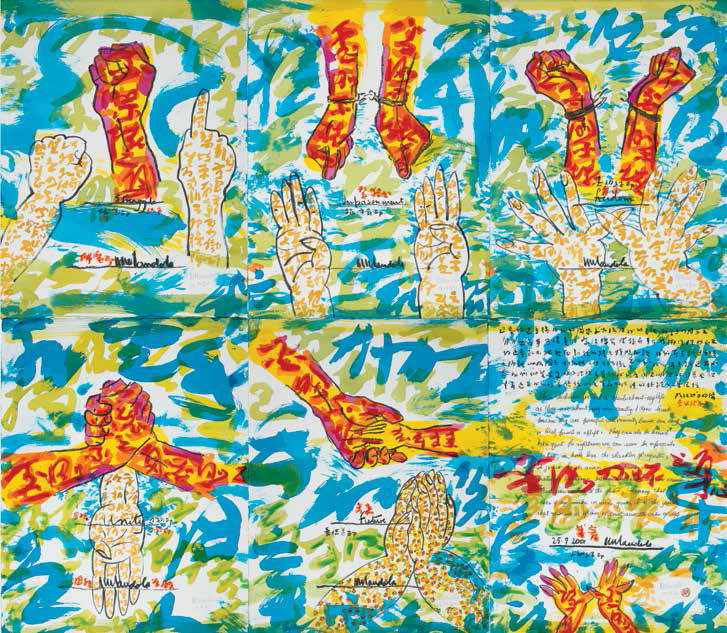
“The Nelson Mandela Unity Series” (2004). Acrylic, ink and pencil on monochrome lithos, 131 cm x 150 cm. Collection of Julien La Chon.
Anatomy of a Free Mind: The Exhibition
The works presented in “Anatomy of a Free Mind: Tan Swie Hian’s Notebooks and Creations” reflect the full depth and diversity of Tan’s creative expressions. Representing a considerable part of Tan’s oeuvre, the exhibition features paintings, sculptures, public art, calligraphy, seal carvings, photographs, lithographs, multimedia creations (dance choreographies, performances and musical compositions) as well as his literary output (poetry, fables and essays). To contextualise his works, the artist transcribed the notes and writings from his notebooks – elucidating the rationale and thinking behind each art piece – to be displayed alongside the works.
As an artist, much of Tan’s output is difficult to pin down and define: versatility and freedom of expression are hallmarks of his works, and much of it cannot be categorised into any particular subject, medium or genre. While the body of works presented in this exhibition has its subtle interconnectedness, a few themes stand out.
Tribute to Masters
Tan Swie Hian is deeply interested in people. He has painted many portraits of personalities – in art, literature, politics and other fields – whom he admires. In this exhibition, portraits and works paying tribute to some of these luminaries can be seen: these include Pablo Picasso, Leonor Fini, Bada Shanren (八大山人), Charlie Chaplin, Franz Kafka, Virginia Woolf, Steve Jobs and Nelson Mandela, to name a few.
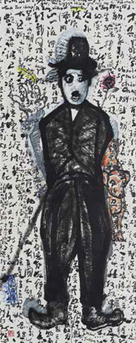
“Graffitied Portrait of Charlie Chaplin” (2013). Ink and acrylic on rice paper, 226 cm x 105.4 cm. Collection of Tan Swie Hian.
One of the paintings, titled “A Couple”, is an unusual portrayal of Lee Kuan Yew, Singapore’s founding prime minister, and his wife as a young couple quite obviously in love. The painting, inspired by a 1946 photograph of the couple when they were law students in Cambridge University, England, depicts Lee Kuan Yew and Kwa Geok Choo in the first blush of youth, and exudes warmth and carefree pleasure – one can almost feel the sunshine that bathes the couple in vibrant colour.
The portrait, which is devoid of any political undertones, is an ode to a love that spanned over six decades. Tan began painting this portrait on Valentine’s Day in 2009 and completed it only in 2014. When Kwa passed away in October 2010, he added two Vanda Miss Joaquim orchids, Singapore’s national flower, by her side as a tribute to the devoted mother and loving wife.
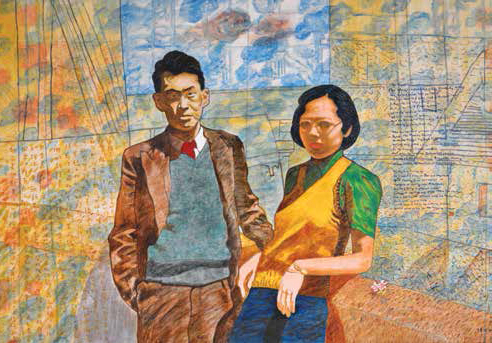
“A Couple” (2014). Oil, acrylic and ink on canvas, 213.5 cm x 339 cm. Collection of Tan Swie Hian.
Spiritual and Philosophical Insights
Perhaps Tan’s most enigmatic and intriguing works are those inspired by his spiritual and philosophical enlightenment. While meditating one day in September 2009, Tan had a vision in which he saw the full moon hovering above the parted foliage of a tree reflected onto a still blue pond. He quickly captured the vision in a sketch in his notebook. The ethereal scene was eventually depicted in the oil and acrylic painting “When the Moon is Orbed”.
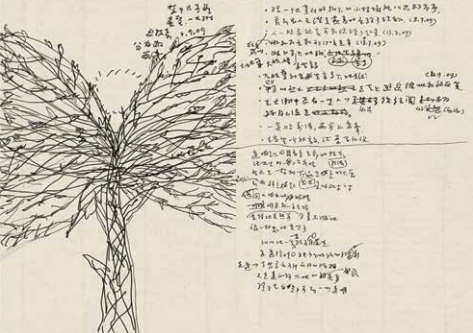
Sketches and notes of the meditative vision which led to the painting, “When the Moon is Orbed”. Donated by Tan Swie Hian. Collection of National Library, Singapore.
The symbolism of the full moon is manifold: traditionally it represents togetherness of people; but in Buddhism, it symbolises the clarity of the mind and the enlightenment of a truth seeker. A smaller-scale reproduction of this work is displayed at the exhibition.
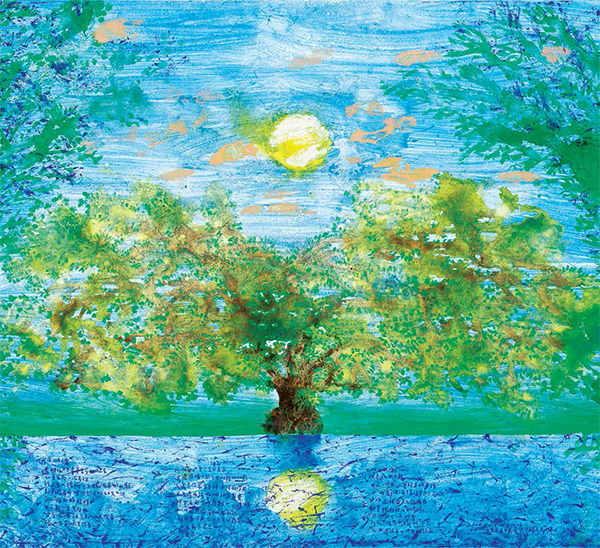
Detail from “When the Moon Is Orbed” (2012). Oil and acrylic on canvas, 140 cm x 206 cm. Private collection.
The centrepiece of the exhibition is a unique mixed media sculpture entitled “The Celestial Web”, a sizable dome-shaped structure made of coiled metal wires adorned with “creatures” moulded from clay. The sculpture, inspired by Tan’s Buddhist faith, is the embodiment of his perspective that all beings, sentient and non-sentient, are interconnected by an immense web of everlasting universal love.
Interestingly, “The Celestial Web” began life as a poem with 117 verses that Tan specially composed for the Singapore Arts Festival in 2003. The poem was inspired by the philosophical teachings in the Buddhist scripture Avatamsaka Sutra, which espouses the notion that all beings in the universe are interconnected and, are in fact, one. The poem was performed at the festival’s opening act, “Instant is a Millennium – A Musical Conversation with Tan Swie Hian”, by the Singapore Chinese Orchestra. The performance took the form of a symphonic orchestration of recitation, chorus and music with the artist simultaneously writing the poem in Chinese calligraphy on stage.[^10]

(Left) Pages from Tan Swie Hian’s notebook showing the sketch of “The Celestial Web”. Donated by Tan Swie Hian. Collection of National Library, Singapore.
(Right) “The Celestial Web” (2010). Mixed media sculpture, 308 cm x 210 cm x 125 cm. Collection of Tan Swie Hian Museum.
The poem subsequently spawned the creation of two other art forms: an oil painting (2003) and the aforementioned sculpture (2010) of the same title. In the 2008 Chingay parade, the concept was reimagined, taking the form of a 22-metre-long by six-metre-high mobile float featuring dancers and a live recitation of the poem. Tan’s uncanny ability to reinvent and morph his literary and artistic creations into other art forms is a distinguishing trademark of his multimedia artworks.
Inspirations from Life
At the same time, one would be wrong to assume that Tan Swie Hian’s art belongs in the esoteric realm of philosophy and spirituality, understood by only a privileged few. In fact, the down-to-earth artist lives a simple and disciplined life revolving around creating art, writing and meditation, and is a keen and compassionate observer of life and the people around him. Occasionally, he takes pleasure in enjoying good food and fine wines with friends.
Tan loves animals, especially cats, and a Chinese ink on paper scroll titled “Cat’s Cradle” is testament to this. In 1984, the artist’s daughter kept a pair of kittens as pets. From observing the kittens’ lively movements when they were playing or fighting, Tan executed the painting as a study of the rhythm of moving lines. The painting, with seven pairs of cats in various poses of action, is so vividly captured that it even incurred the jealousy of another pet cat of his daughter’s – she kept glaring and mewing at the painting!
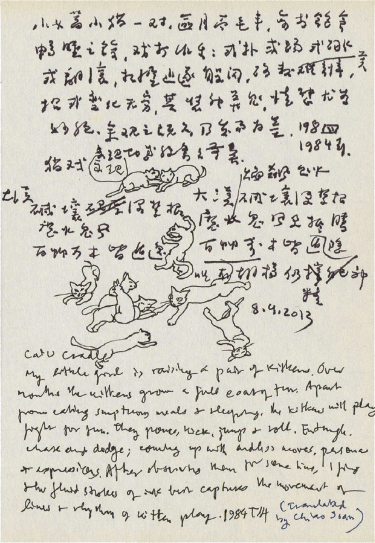
Tan Swie Hian’s sketches and notes on the painting. Donated by Tan Swie Hian. Collection of National Library, Singapore.
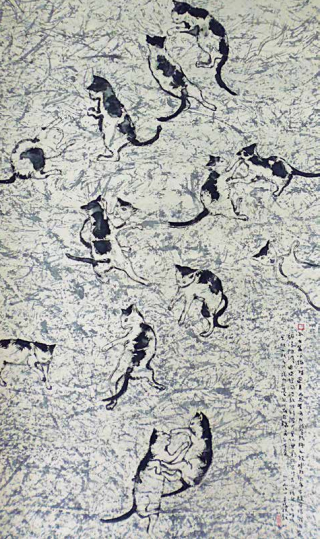
“Cat’s Cradle”. (1984). Chinese ink on rice paper, 184 cm x 87 cm. Collection of Tan Chiao Joan.
On 26 December 2004, in a cataclysmic event that would be remembered in years to come, an earthquake in Indonesia triggered a tsunami in the Indian Ocean that struck 14 countries, claiming the lives of more than 230,000 people.[^11] In memory of the lives lost to this tragedy, Tan created the sculpture, “The Straw Dog”.
The concept for the sculpture came from a quote by Lao Tze (also Lao Tzu or Laozi, the Chinese philosopher) in the classic Tao Te Ching (道德经) which says that “Heaven and Earth are merciless, treating all beings as straw dogs.” (“天地不 仁,以万物为刍狗。”). In ancient China, the straw dog was a sculpted object offered in worship, to be discarded after sacrificial rites were offered. As no visual reference of the actual object exists, Tan created the sculpture from his imagination. The austere looking bronze sculpture is a grim reminder of the vulnerability and fragility of life.
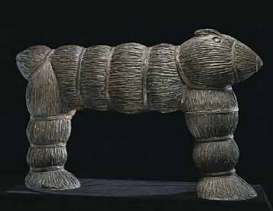
“The Straw Dog” (2004). Bronze sculpture, 153 cm x 40 cm x 90 cm. Collection of Tan Swie Hian Museum.
Tan held his first ever solo art exhibition in 1973 when “Paintings of Infused Contemplation” opened at the since demolished red-brick National Library building on Stamford Road. Almost 43 years later, in November 2016, the artist returns to the National Library with “Anatomy of a Free Mind” – the first ever exhibition to showcase his private notebooks and illustrious body of works created during that long absence. The National Library is honoured to partner Tan Swie Hian in charting and presenting his fascinating creative journeys over the past four decades.
Over the years, Tan has generously donated more than 6,600 items from his personal collection to the National Library, including artworks and artefacts as well as manuscripts, notebooks and monographs. These are displayed at the Lee Kong Chian Reference Library at the National Library Building. His most recent donation includes the collection of notebooks displayed in the exhibition.
ABOUT THE EXHIBITION
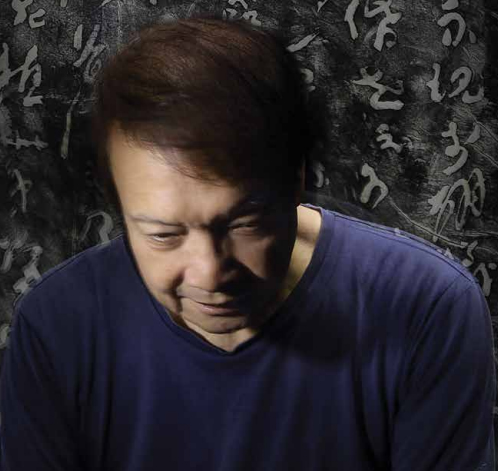
Portrait of Tan Swie Hian. Collection of Tan Swie Hian.
“Anatomy of a Free Mind: Tan Swie Hian’s Notebooks and Creations” opens
on 22 November 2016 at the gallery on Level 10 of the National Library
Building on Victoria Street.
The exhibition will feature over 100 works of artistic and literary creations
by Tan Swie Hian comprising paintings, sculptures, calligraphy, seal carvings,
photographs, lithographs, and multimedia and literary works.
Tan’s notebooks, manuscripts and related paraphernalia will be also displayed
alongside the respective artworks.
To commemorate the exhibition, a 272-page companion book of the same name,
published by the National Library and Editions Didier Millet, will be launched
at the exhibition and sold at major bookshops in Singapore as well as on
online stores. The book includes an introduction and notes by writer Yap
Su-Yin, and essays by Tan that shed light on his explorations of new artistic
mediums.
A series of programmes has been organised in conjunction with the exhibition,
including monthly guided tours by the curators and public talks. Of special
highlight is a guided tour that is open to the public and a talk by the
artist himself.
Also look out for the smaller scale roving exhibition on Tan’s literary
works that will take place at the Jurong Regional Library (1 November–29
December 2016) followed by the Central Public Library (30 December 2016–28
February 2017).
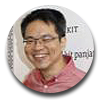
Chung Sang Hong is Assistant Director (Exhibitions & Curation) at the National Library, Singapore. He is the lead curator of the “Anatomy of a Free Mind: Tan Swie Hian’s Notebooks and Creations” exhibition.
Notes
[^1]:Princeton University Press (Producer). (2010, October 25). Michelangelo: A life on paper [Video file]. Retrieved from Brain Pickings website.
[^2]:Esplanade – Theatres on the Bay. (n.d.). Tan Swie Hian. Retrieved from Tribute.sg website.
[^3]:From a personal communication with Tan Swie Hian on 27 June 2016.
[^4]:Yap, S. Y. (2016). Anatomy of a free mind: Tan Swie Hian’s notebooks and creations. Singapore: National Library Board and Editions Dider Millet. Call no.: RSING 700.92 CHE
[^5]:Tan, S. H. (2005). Tan Swie Hian. Retrieved from Tan Swie Hian website.
[^6]:National Library Board. (2014, February 26). Tan Swie Hian written by Chor, Poh Chin. Retrieved from Singapore Infopedia.
[^7]:Luxury Insider. (2012, December 4). Most expensive living Singapore artist: Tan Swie Hian sells for S$3.7M. Retrieved from Luxury Insider website.
[^8]:Shetty, D. (2014, December 1). Tan Swie Hian’s work fetches record S$4.4 million at auction. The Straits Times, p. 8. Retrieved from NewspaperSG.
[^9]:Mandela-Tan Swie Hian work sold for $630k. (2016, May 31). The Straits Times, p. 14. Retrieved from NewspaperSG.
[^10]:Singapore Chinese Orchestra. (2006). The Celestial Web [Recorded by Terence Cho]. Singapore: Singapore Chinese Orchestra Co Ltd.
[^11]:Akkoc, R. (2014, December 11). 2004 Boxing Day tsunami facts. The Telegraph. Retrieved from The Telegraph website.

